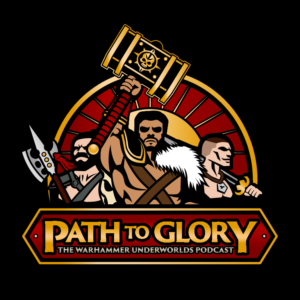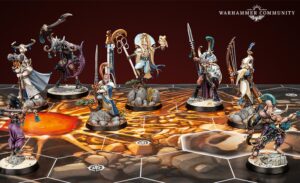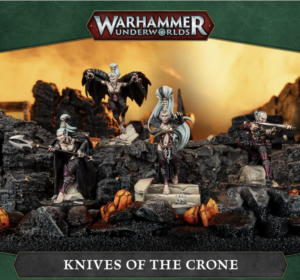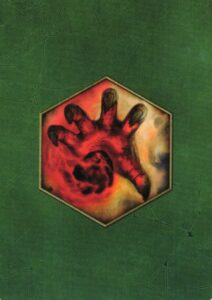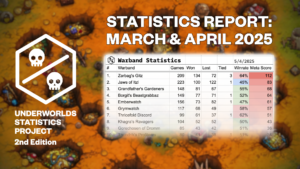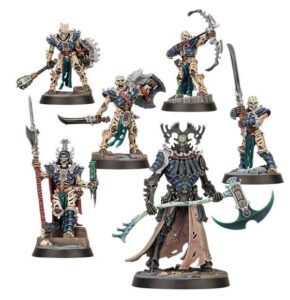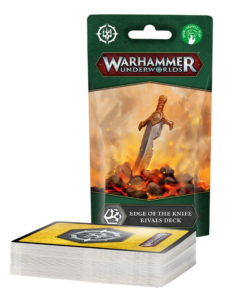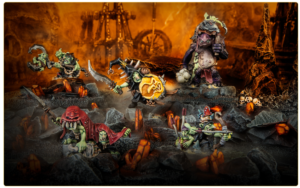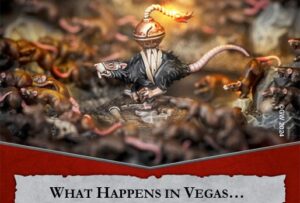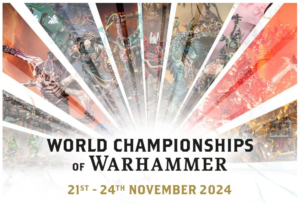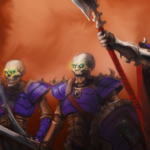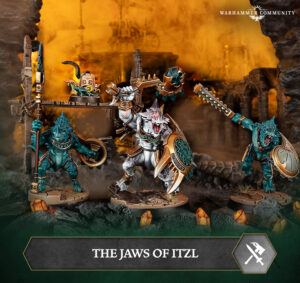Warhammer Underworlds has been a fixture in the miniatures gaming scene since 2017 – a real granny in a fast-moving industry. It’s Games Workshop’s take on boiling down the complexity of larger tabletop wargames into a tight, card-driven skirmish experience. Think miniatures meets trading card game, minus the actual trading part.
For my money, it’s probably one of the best entry points into tabletop gaming. It’s relatively easy to pick up, though certainly challenging to master. Games clock in under an hour, and the low model count means you don’t need to dedicate your life to painting (unless you want to, of course). It’s definitely a lifestyle game, kept fresh with new releases dropping every couple of months.
Then came November 2024, and after a few quiet months, we got the new edition: Embergard. This was a hard reset. First edition materials? Mostly obsolete. Old warbands got new rules – some bespoke, others more generic. Your old decks? Invalid.
The release was accompanied by a lot of hype and skepticism, giving the game a level of visibility it hadn’t seen in ages. But the big question is: is it actually good? Is this the ultimate blend of “miniatures, cards, combat”?
As someone who’s been playing since 2021, almost weekly, organizing World Championship qualifier events, and helping run a global stats project (and being a mediocre player at best, mind you), I feel I can offer a qualified perspective on what’s good, what makes you shrug, and what’s just plain bad about this new edition. And I’m going to be honest about it.
Just to be clear, this is absolutely a subjective review. I’m not trying to invalidate anyone else’s enjoyment or perspective. I genuinely love this game and believe it’s one of the best tabletop experiences out there. But like anything you care about, you see its flaws.
The Good
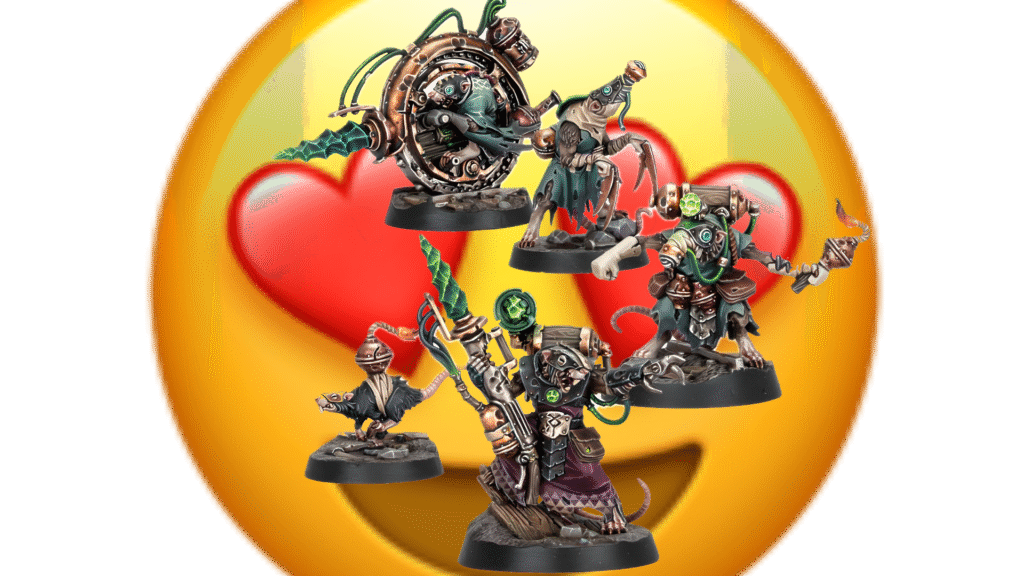
First off, the core game itself hasn’t fundamentally changed, and that’s a great thing. There really isn’t another game quite like Underworlds. If you’re looking for a complex, engaging puzzle of a miniature game that you can finish in under an hour, this still delivers.
The complete reset, while painful for some who lost beloved warband rules or extensive card collections, was honestly necessary. Games Workshop tends to focus on new releases rather than fixing old ones, and things had gotten pretty messy. Many of the improvements we see now wouldn’t have been possible without that drastic cut.
The starter box for Embergard is genuinely attractive. You get two warbands, including the popular Skaven, and four decks. Using the Nemesis format (combining two decks), that gives you six unique combinations right out of the gate. Good value there.
The rules themselves feel streamlined. The first edition had accumulated a lot of addendums and special cases over the years. The new rules are laid out more logically and seem to address many common complications. While I personally didn’t mind the old flowcharts, the fact that you need them less now is probably a win, especially for new players.
Keywords are better standardized now, which helps reduce rules bloat further by giving common effects consistent icons and definitions.
Setup is faster and simpler. You do one dice roll to determine who goes first, and then follow a straightforward process. It’s less complex than the multiple rolls and multi-step board placement decisions of the first edition. You play on a single, standardized board. This means less to collect and carry, and while board orientation and fighter deployment are still important, a bad choice isn’t as game-deciding as it could be before.
The bespoke warband releases after the starter set have been pretty good. Sculpting quality is generally high, and they capture the feel of their larger faction well. While the starter warbands felt a bit generic rule-wise, the subsequent releases have introduced some genuinely unique mechanics.
Playstyle flexibility is much higher now. The warband you choose feels less important than the deck combination you bring. The warband is almost like a skin or a platform for the playstyle dictated by your cards. Most strong deck combinations can work reasonably well with almost any warband. This is a big shift from the first edition, where warbands came with their own fixed deck, and combining it with just one other deck in the Nemesis format meant your playstyle was often locked in.
There’s less to remember during gameplay. Everything special about a warband is on a single, larger warscroll card. Fighter cards have minimal special rules. Most other effects come from the decks, and currently, there are only eight universal ones. You quickly learn which cards and deck combinations are popular, so you get a basic idea of what opponents are trying to do after just a few games. This is a big improvement over the first edition, where faction decks could contain complete surprises.
Rules support is slightly better. While we’re still dealing with PDFs that tell you to change card text instead of providing updated cards (which is annoying), the documents are better structured and relatively short so far.
Finally, organized play support remains strong. Underworlds is part of the World Championship circuit, with qualifiers run globally by volunteers and GW. There are Underworlds-specific prize kits for organizers. The community, while small, is well-connected online.
The Shrug
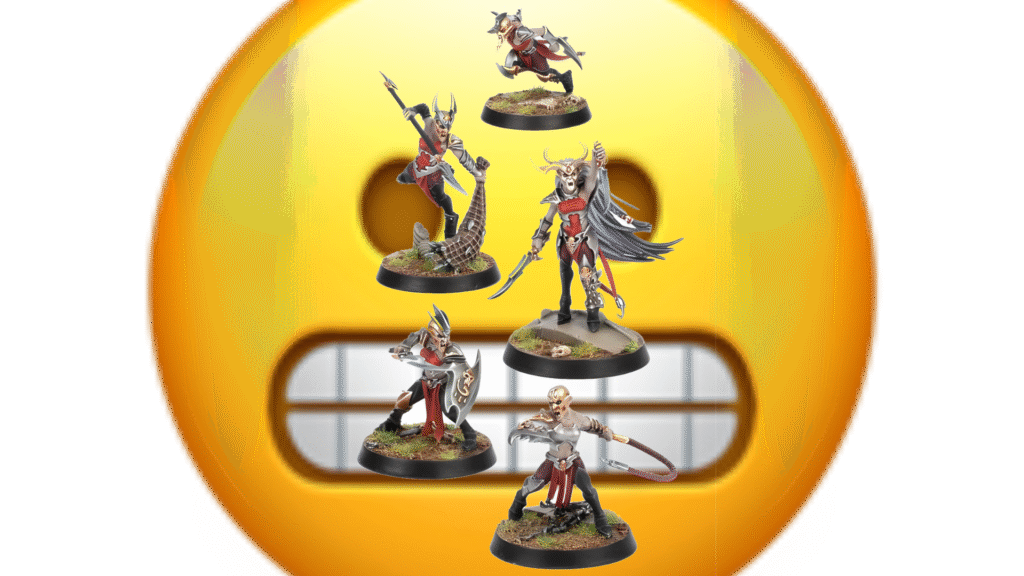
Now for the things that aren’t necessarily bad, but just… make you shrug.
There’s a pretty random “rubberband” mechanic now. If you’re behind on glory (victory points) by at least one point, certain objectives become easier to score. The idea is to prevent snowballing, which is a valid concern. However, being down just one or two points doesn’t always mean you’re in a worse position strategically. Plus, some of the objectives that get easier were already fairly simple to score. I’m not convinced this mechanic works as intended in its current form, but it’s not game-breaking either.
The power level feels significantly higher. In the first edition, Nemesis format (combining two pre-defined decks) generally led to lower power levels compared to the now depreceated Championship format (building from a large card pool). The second edition core decks include reprints of some of the best cards from the first edition, plus powerful new ones. It feels like a weird blend of Championship and Nemesis power level. I personally preferred the slightly less optimized feel of first edition Nemesis, but the overall power increase is something I can live with.
The game seems to have a bit of an identity crisis regarding its target audience. It was previously pitched as the most competitive miniature game, and its abstract nature, clear rules interactions, and manageable card pool certainly support that. At the same time, marketing often frames it as a simple, quick game you can play casually in your lunch break (which apparently is the most common setting for a game night according to GW). A ruleset that supports competitive play through clarity is also great for casual players, so there’s synergy. But Underworlds sometimes seems torn between wanting tight optimization and wanting more random, “funny” effects. This feels slightly detrimental to both audiences, who often overlap significantly anyway.
Game time feels longer for our local community, and from what I’ve heard, this lines up with other experiences as well. In theory, the new edition should be faster, but our games often run longer. This could be due to lack of routine, the higher power level leading to fewer quick wins, or more game effects requiring extra bookkeeping. I’d prefer games to be quicker, but an extra 5-10 minutes is tolerable.
The Bad
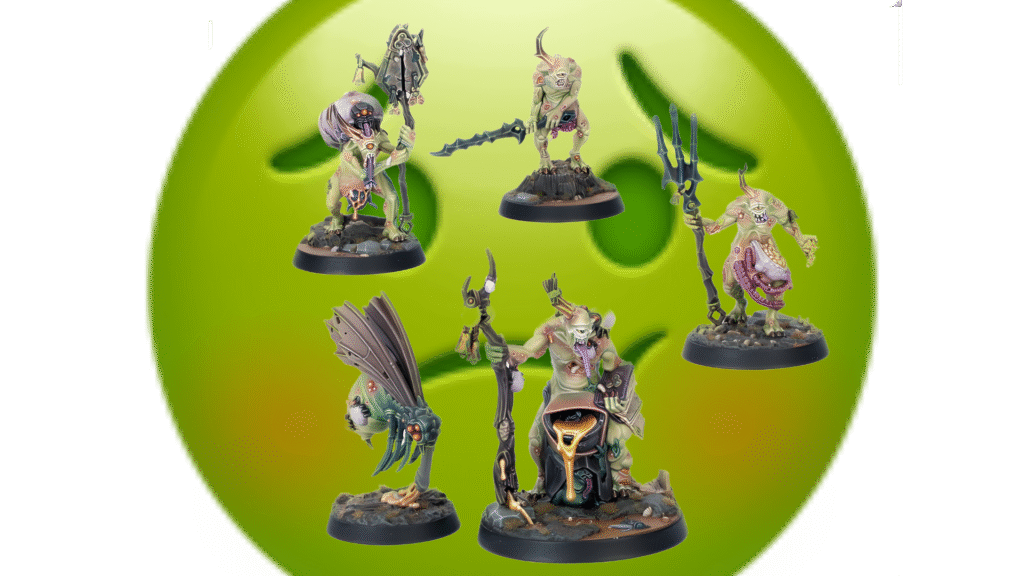
Here’s where the real issues lie, in my opinion.
There’s a distinct lack of identity and true variety right now. With warbands having just one warscroll card for their unique rules, and the core decks being so strong and generic they work with almost any warband, things feel a bit same-y. Warbands score the same glory when taken out, and their base durability is often similar without specific card effects. If you play a lot, you might find yourself thinking, “Okay, this is just [Deck Combo] with a different skin.” The basic Underworlds playstyles are there, but the warbands themselves feel less distinct as the primary driver of that style.
The power level isn’t just higher; it’s inconsistent. Some updated warbands are clearly weaker than others. Bringing back top-tier upgrades and ploys from the first edition with no restrictions feels odd, making many new upgrades seem suboptimal unless they are completely overtuned. But the biggest issue is the decks themselves.
The deck releases have been inconsistent and often disappointing. Decks are more important than ever, but their quality varies wildly. The core set decks are strong but generic. Then we got an overtuned aggro deck that needed immediate errata, a decent control deck, a flex deck with weak objectives that struggles outside specific pairings, and a recent aggro deck with mechanics so convoluted I regret buying it. It’s no wonder the game currently revolves around the core set decks and only a few combinations of them. The newer releases often don’t feel like they align well, which might suggest the core set decks themselves are part of the problem.
Balancing feels too slow. The last update was in early January, and it’s now mid-May. Competitively, the game felt pretty much “solved” by late February. For a game intended for tournament play, it feels like it’s been left to stagnate. This isn’t just a competitive player issue; even more casual players who engage with the community quickly learn that the game is largely about X + Countdown to Cataclysm, or that Blazing Assault + Countdown to Cataclysm works well with almost anything. It gets boring without regular shake-ups.
Finally, the re-release decisions and product distribution have been strange and inconsistent. When you reset a product line and invalidate purchases, you’d think you’d update the most recent products first. That happened, mostly, but some recent ones were skipped while older ones were bundled into expensive combo boxes with new rules. Others got generic rules. For players, it would have made more sense to properly update warbands from the last couple of years and give generic rules to the truly old stuff. The identity of some beloved warbands was completely changed, or they became power-wise irrelevant, frustrating existing players. On top of that, the updated rules for re-released warbands are officially only available if you buy one of four combo boxes (€80), which might require you to purchase multiple ones, or a card pack for all re-releases (€40), which is perpetually out of stock and already partially invalidated by errata. This has been a real turn-off for both new and existing players who already own some of these older miniatures.
The Conclusion
I stand by it: Underworlds is an amazing game that I constantly try to get people into. That hasn’t changed with the second edition, and I think the core design is even better. So, new players with a more casual interest are well served.
However, I see issues for existing players and those who become more experienced, especially long-term. Right now, you quickly learn the dominant deck combinations and the warbands that pair best with them. You tend to ignore the theoretical variety because many options just don’t compete. And you can feel like you’re just slapping any deck onto any warband and getting the same basic playstyle you’ve seen for months. That becomes a problem, particularly if you’re already frustrated that half your old collection isn’t properly usable and you miss the truly unique feel of old faction decks (even if some warbands were terrible because of those decks).
The good news is that most of this is fixable with more proactive balancing. Card text changes could help, but even just restricting or banning problematic cards could shake things up significantly. The inconsistency in deck releases is a deeper issue that plagued the first edition too. In my opinion, future decks need to:
- Properly support any fancy new mechanics they introduce, as no other deck will.
- Have a clear gameplay identity and stick to it – don’t ask players to do contradictory things.
- Include two 2-glory end phase objectives that are reasonably achievable with the deck’s strategy. Three conditions are usually too many. If scoring ties into a unique mechanic, ensure there’s ample card support for it.
- 1-glory objectives need to be more consistent and easier than 2-glory ones, usually with only two conditions. At the same time, objectives whose scoring is basically automatic or tied to rolling a specific face of a die should be avoided. Where’s the challenge or fun in that?
- 3-glory objectives should be consistently balanced across decks. Don’t make one deck’s 3-glory objective significantly easier than others.
- And please, just don’t do 5-glory objectives. Ever. They’re either bonkers or completely irrelevant, and lead to a deck missing the essential 2-glory objectives.
- Ploys and upgrades, as a whole, should align with other decks. This means either reducing the power of Core Set decks or ensuring that future decks match their power level, but without overshooting, as seen with Reckless Fury.
Let me know what you think.
